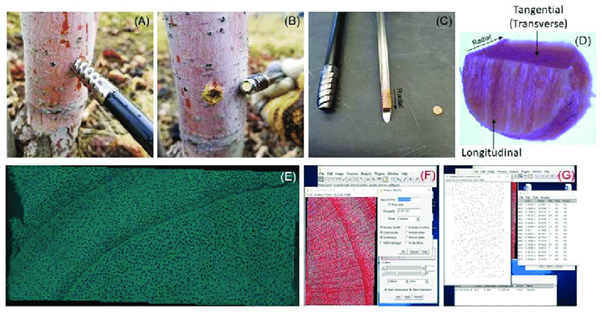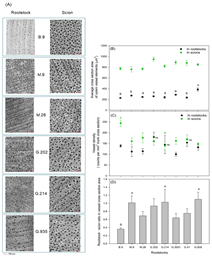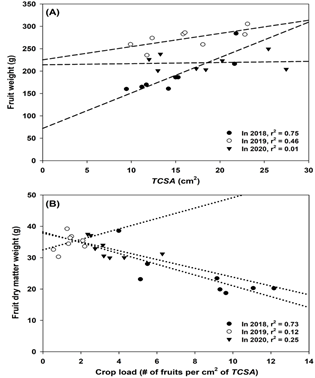July 20, 2021 at 7:23 am | Updated April 11, 2022 at 6:44 am | 7 min read
Rootstocks could influence not only yield and vigor, but also water relations in scions. Water relations in rootstocks and scions play an important role in growing apple trees. However, it is not clear if hydraulics is influenced by xylem vessels’ characteristics and how it happens. Knowing more could help in finding apple rootstocks better suited for specific regions with varying climatic conditions.
Apple Rootstocks and Scions
Rootstocks can regulate the vigor and yield of scion in grafts by influencing nutrient content, fruit size, and health in growing apple trees.
Apple rootstocks with internal hydraulic limitations are used to dwarf scion vegetative growth and improve yield efficiency. The rootstocks are less vigorous because there is less water transportation due to less root mass, smaller xylem vessels, or lower root hydraulic conductance. However, the influence that rootstocks can have on scion xylem characteristics is unknown.
Subscribe to the Felix instruments Weekly article series.
By submitting this form, you are consenting to receive marketing emails from: . You can revoke your consent to receive emails at any time by using the SafeUnsubscribe® link, found at the bottom of every email. Emails are serviced by Constant Contact
The dwarfing rootstocks could be changing root-to-shoot signals by changing water availability to scions, which can then influence the development of scion xylem. This is because environmental factors like water and nutrient availability, along with genes and stem size, affect xylem growth and development.
Also, trees with lower water availability have smaller xylem vessels but higher vessel density and, as a result, suffer from less embolism.
Apple Rootstocks’ Influence and NIR
Given the wide-ranging influence that rootstocks exert on scions, it is not surprising that scientists need many years to evaluate and choose suitable rootstocks by studying the grafts. Understanding the effect of rootstock hydraulics on scion growth and yield efficiency could reduce assessment time of rootstocks and help in predicting their influence on yield.
Xu, Ediger, Singh, and Pagliocchini, agriculture scientists in Canada, experimented to check if the rootstock xylem vessels influenced xylem vessels and water relationships in Honeycrisp scion (Malus domestica cv. ‘Honeycrisp’). They also wanted to check if yield efficiency depended on total vessel cross-section area (VCSA) in rootstock and scion xylem.
The agriculture scientists chose ten-year-old Honeycrisps grafted on eight apple rootstocks, which included dwarfing and semi-dwarfing varieties: one Budagovsky rootstock (B9), two Malling rootstocks (M.9 and M.26), and five Geneva rootstocks (G.41, G.202, G.214, G.935, and G.3001). These grafts were grown in the farm at the Summerland Research and Development Centre, BC.
Plant-water relations, nutrient status, fruit dry matter, and cumulative yield efficiency from 2014 to 2019 were recorded.
As part of tree growth parameters, the trunk cross-section diameter (TCSA) was measured by digital calipers at a height of 30 cm. Crop yield was the number of fruits harvested per cm2 of TCSA, and yield efficiency was the weight of fruits at harvest per cm2 of TCSA. Cumulative yield efficiency was the sum of yield efficiency for six years, from 2014 to 2019.

Figure 1: “Xylem sample preparation and vessel element analysis. (A, B) Secondary xylem sample was collected from a living tree using an increment borer; (C, D) Transverse section of xylem sample was prepared in the laboratory and under a stereomicroscope; (E) Autofluorescence of the section was visualized through a confocal microscope; and, (F, G) The acquired image was analyzed in ImageJ for the calculation of size, density, and the percentage of the total cross-section area of vessel elements,” Xu et al., 2021. (Image credits: Horticulturae 2021, 7(5), 99; https://doi.org/10.3390/horticulturae7050099 )
To find the tree water relations, the scientists measured the leaf photosynthetic rate, transpiration rate, and stomatal conductance, using a photosynthesis system before noon in summer (August 2019). Water use efficiency was calculated as a ratio of photosynthetic and transpiration rates. The stem water potential was measured on the same day.
As explained in Figure 1, the scientists used an increment borer to get secondary xylem samples from a 2 cm piece of sap wood. Both rootstock and scions’ samples were taken by sampling 2.5 cm above and 2.5 cm below the graft union. A thin disc of the wood core was taken. To remove the bark, phloem, and cambium, an external ring of 0.5 cm was removed. A small bit of the transverse side of the stem was then examined under the microscope to get the xylem vessel parameters: density, size, and percentage of the total cross-section area of vessels (VCSA%). The total VCSA was calculated by multiplying VCSA% by TCSA.
Chlorophyll and nutrient content were measured in five leaves in each of the three trees randomly selected per rootstock.
The scientists harvested fruits from all the rootstocks on the same day. They picked five fruits from six trees to get a total of 30 fruits from each rootstock. The scientists recorded the fresh weight of all sampled fruit with a bench scale.
Then, they needed to make dry matter measurements (DM%). If they had used the conventional oven drying method, the samples would have to be destroyed, and the process itself is long and tedious. Therefore, the scientists decided to use the F-750 Produce Quality Meter. The tool uses near-infrared spectroscopy (NIRs) to determine dry matter content. The NIR measurements are accurate and rapid. Each dry matter measurement is obtained in under twelve seconds, and the device can take 1500 NIR measurements with a single battery charge.
The predictions based on NIR measurements can be transferred easily through a USB connection to a computer. Manufactured by Felix Instruments – Applied Food Science, the near-infrared spectroscopy tool is small and portable, has a customized model for apples, and is regularly used for research.
The agriculture scientists calculated the moisture content of fruits as 100 minus dry matter measurement, as the dry matter is the total of all solids in a fruit, exclusive of water content.
Both Rootstocks and Scions are Important
Rootstocks’ vigor is classified based on the final tree size. In this study, the agriculture scientists found that the rootstocks produced small to large trees, measured in terms of trunk diameter, tree height, and canopy width of the scions.

Figure 2: “Characteristics of xylem vessel elements in 10-year-old Honeycrisp trees in the combination with eight rootstocks. (A) Cross-section of xylem vessel elements in rootstocks and scions, with autofluorescence visualized under 100× magnification of a confocal microscope; (B) Average size of the cross-section of individual xylem vessel elements in scions and rootstocks; (C) Xylem vessel density in scions and rootstocks; and, (D) Rootstock: scion ratio in total xylem vessel cross-section area (VCSArootstock: VCSAscion),” Xu et al., 2021. (Image credits: Horticulturae 2021, 7(5), 99; https://doi.org/10.3390/horticulturae7050099 ).
The scientists, however, found no correlation in the vessel size or density between rootstocks and scions.
The xylem vessel sizes were significantly larger in scions than the rootstocks in all the grafts studied, as seen in Figure 2(B). The trend was not so clear cut for vessel density, but scion vessel density was higher or nearly equal to that in rootstocks; see Figure 2(C). Vessel size and density were not significantly different between dwarfing and semi-dwarfing grafts, so hydraulic restrictions are not the sole effect of dwarfing.
Rootstock VCSA
Though there is no correlation between xylem vessels in rootstocks and scions within a graft, the rootstock VCSA and TCSA are correlated with scion growth and yield; see Figure 3 (A).
- Rootstock G.202, a moderate semi-dwarfing rootstock, had the largest TCSA and VCSA. It also produced scions with the highest TCSA and VCSA. This rootstock also produced the highest cumulative yield. This, however, happened at the cost of higher water use and lower water use efficiency.
- Rootstock B.9 had the least TCSA and VCSA, and it produced the least vigorous scion.
- G.935 had a higher VCSA due to larger vessel size, and it produced one of the best yield and yield efficiencies, even though the vigor of the graft was low. Its moderate water use makes it the best candidate for areas with low water availability.
Apple trees are subject to biennial bearing, where they produce more fruit of a smaller size in “on years” and fewer fruit the following year, even in good environmental conditions. The grafts in this experiment could not overcome this effect. Rootstocks that produced higher yields had more inter-annual variations in the number of fruits they produced. Similarly, lower vigor rootstocks also saw the highest variation in crop load. It is, therefore, necessary to manage fruit load to maintain quality during “on years.”
Trees with larger rootstock TCSA and higher vigor produced heavier fruits, as shown in Figure 3(A). Trees with less vigor could, therefore, produce smaller fruits in “on years.” In all grafts, more fruit yield led to lower fruit dry matter; see Figure 3(B). As the number of fruit increases, each gets less of the carbohydrates produced by the tree, as the fruit-fruit and leaf-fruit competition for biomass and water increases.

Figure 3: “Correlations between rootstock trunk cross-section area and fruit weight (A), and between crop load and fruit dry matter weight (B), of Honeycrisp apples across rootstocks in 2018, 2019, and 2020. Each dot stands for the mean of three trees of a rootstock,” Xu et al., 2021. (Image credits: Horticulturae 2021, 7(5), 99; https://doi.org/10.3390/horticulturae7050099).
Scion VCSA
Rootstock and scion VCSA ratios that were one or greater produced the highest yield and yield efficiency; see Figure 2 (D). Moderate water users, such as rootstocks M.9, G.214, and G.935 in Honeycrisp, showed this ratio.
Scion VCSA, which depended on the size and density of vessels, and the TCSA influenced scion water and nutrient use.
- G.202 scions had a higher VCSA that contributed to its high water use and low water use efficiency.
- G.41 scions had a high water use efficiency but low yield.
- B.9 scions had the smallest TCSA, due to small vessel size but high density. Though yields are low, it is a moderate user of water and produces early fruits, making it interesting for colder and drier regions.
The height and canopy width of scions were positively correlated with scion TCSA and yield. So, scions with higher TCSA produced better vegetative growth as well as yield. Since yield had a higher correlation to TSCA than canopy width, the former is a better predictor of the final yield capacity of the apple grafts.
A Breakthrough
Higher rootstock vessel size and scion vessel density could be important traits for predicting the yield efficiency of grafts. Since one of the main aims of the study was to speed up rootstock and scion combination selection, the work is a breakthrough for producing apple grafts. To shed light on the dwarfing mechanism, the scientists recommend various additional studies and hypotheses, similar to this experiment, that investigate water vessel characteristics thoroughly, at various ages of grafts and in many varieties. The scientists have also identified a novel method of studying xylem vessels by showing how sampling by the increment borer can work. Moreover, the study has been able to recommend individual rootstock-Honeycrisp combinations for various geographies, depending on the tree-water correlations with yield, which is by no means a small achievement.
—
Vijayalaxmi Kinhal
Science Writer, CID Bio-Science
Ph.D. Ecology and Environmental Science, B.Sc Agriculture
Sources
Xu, H., Ediger, D., Singh, A., & Pagliocchini, C. (2021). Rootstock–Scion Hydraulic Balance Influenced Scion Vigor and Yield Efficiency of Malus domestica cv. Honeycrisp on Eight Rootstocks. Horticulturae, 7(5), 99. https://doi.org/10.3390/horticulturae7050099
Related Products
- F-751 Grape Quality Meter
- Custom Model Building
- F-901 AccuRipe & AccuStore
- F-751 Melon Quality Meter
- F-751 Kiwifruit Quality Meter
- F-750 Produce Quality Meter
- F-751 Avocado Quality Meter
- F-751 Mango Quality Meter
- F-900 Portable Ethylene Analyzer
- F-950 Three Gas Analyzer
- F-920 Check It! Gas Analyzer
- F-960 Ripen It! Gas Analyzer
- F-940 Store It! Gas Analyzer
Most Popular Articles
- Spectrophotometry in 2023
- The Importance of Food Quality Testing
- NIR Applications in Agriculture – Everything…
- The 5 Most Important Parameters in Produce Quality Control
- Melon Fruit: Quality, Production & Physiology
- Guide to Fresh Fruit Quality Control
- Liquid Spectrophotometry & Food Industry Applications
- Ethylene (C2H4) – Ripening, Crops & Agriculture
- Fruit Respiration Impact on Fruit Quality
- Active Packaging: What it is and why it’s important






